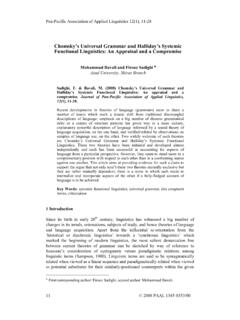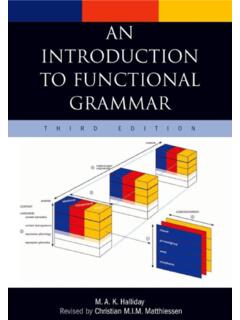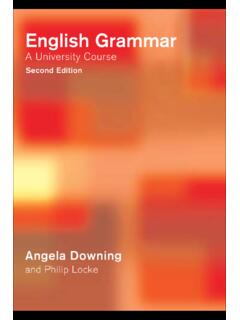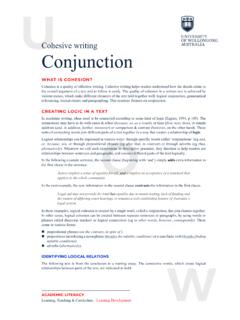Transcription of Functional Grammar and Its Implications for English ...
1 English Language Teaching; Vol. 6, No. 10; 2013 ISSN 1916-4742 E-ISSN 1916-4750 Published by Canadian Center of Science and Education 86 Functional Grammar and Its Implications for English Teaching and Learning Zhiwen Feng1 1 School of Foreign Languages, Yunnan Normal University, China Correspondence: Zhiwen Feng, School of Foreign Languages, Yunnan Normal University, Kunming, Yunnan, China. Tel: 86-138-8859-9089. E-mail: Received: July 5, 2013 Accepted: July 30, 2013 Online Published: September 4, 2013 URL: Abstract Functional Grammar has received more and more attention from domestic scholars in the world of linguistics since 1970s, but it is still new to most EFL teachers.
2 In spite of controversies about its applications into classroom teaching, this new Grammar model has its own advantages and can facilitate EFL students to achieve academic success. This paper, based on current literature, examines and analyzes the following issues: the nature of Functional Grammar , the key concepts of Functional Grammar , the fundamental differences between traditional Grammar and Functional Grammar , and the Implications for English teaching and learning. The purpose of this paper is to help EFL teachers have an overall understanding of the theory and key concepts of Functional Grammar as well as the positive role Functional Grammar plays in school contexts.
3 Keywords: Functional Grammar , traditional Grammar , EFL teachers, EFL students 1. Introduction Functional Grammar , a Grammar model developed by Michael Halliday in the 1960s, while still new to most EFL teachers, has aroused great interest for researchers. In spite of controversies about its application into classroom teaching, ( too many concepts and terms) Functional Grammar is gaining popularity in schools and is helpful for EFL students to achieve success. In the field of language teaching, Functional Grammar has more applications to speaking and writing.
4 The main reason is that Functional Grammar serves the communicative purpose of EFL students learning the English language and provides the opportunity for EFL students to recognize the linguistic features of the language, which they need to learn for success at school (Schleppegrell, 2004). This paper is based on literature review and discusses four questions: What is Functional Grammar ? What are the key concepts of Functional Grammar ? What are the fundamental differences between traditional Grammar and Functional Grammar ?
5 What are the Implications for English teaching and learning? The purpose of this paper is to help EFL teachers have an overall understanding of the theory and key concepts of Functional Grammar , and to realize its importance for EFL students to achieve success in school contexts or academic registers. Bloor (2005) argues that a language teacher ought to know as much as possible about the language and that knowledge should include, as a major component, knowledge about Grammar ; and that given a good command of the target language, a non-native speaker with appropriate professional training and a good understanding of the way that the language works can do an excellent job.
6 Accordingly, through a detailed discussion of Functional Grammar , this paper will facilitate the present language teaching and learning. 2. What is Functional Grammar ? Functional Grammar , based on systemic linguistics, emphasizes the way spoken and written language operate in different social situations. In particular, it is very useful in showing how texts work beyond the level of the sentence, how different texts are structured, and how language varies to suit the purpose of the users. It takes on a descriptive approach and focuses on groups of words that function to make meanings.
7 In his classic book An Introduction to Functional Grammar , Halliday (1994) points out that Functional Grammar is so-called because its conceptual framework is a Functional one rather than a formal one. It is Functional in three distinct senses: in its interpretation (1) of texts, (2) of the system, and (3) of the elements of linguistic structures. In the first sense, Functional Grammar is designed to account for how the language is used. Every text (everything that is said or written) unfolds in some context of use.
8 Over tens of thousands of generations of English Language Teaching Vol. 6, No. 10; 2013 87 constant use, language has shaped into a system which can satisfy human needs. Therefore, A Functional Grammar is essentially a natural Grammar , in the sense that everything in it can be explained, ultimately, by reference to how language is used (Halliday, 1994, p. xiii). In the second sense, the fundamental components of meaning in language are Functional components. According to the analysis of Halliday, all languages are organized around two kinds of meanings, the ideational (to understand the environment), and the interpersonal (to act on the others in it).
9 Combined with these two is a third component, the textual , which breathes relevance into the other two. These three components are called metafunctions in the terminology of FG theory. In the third sense, each element in a language is explained by reference to its function in the total linguistic system. Accordingly, a Functional Grammar is one that construes all the units of a language its clauses, phrases and so on. In other words, each part is interpreted as Functional with respect to the whole (Halliday, 1994, p.)
10 Xiv). Based on Halliday s model, Thompson (1996) explains the three metafunctions of Functional Grammar in an informal way as follows: 1) we use language to talk about our experience of the world, including the world in our minds, to describe events and states and the entities involved in them. 2) We also use language to interact with other people, to establish and maintain relation with them, to influence their behavior, to express our own viewpoint on things in the world, and to elicit or change theirs.













